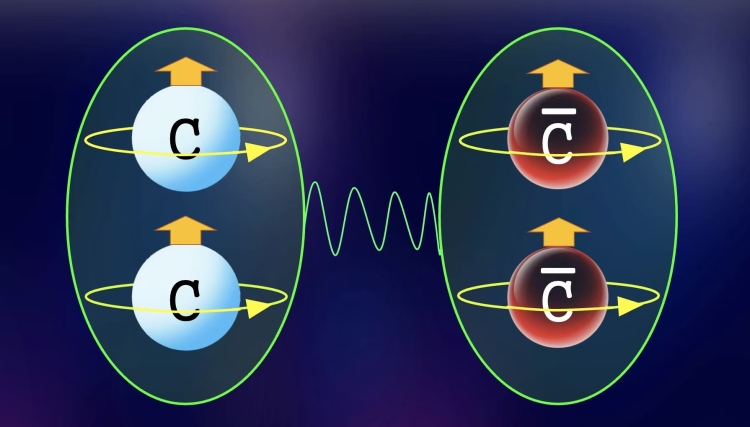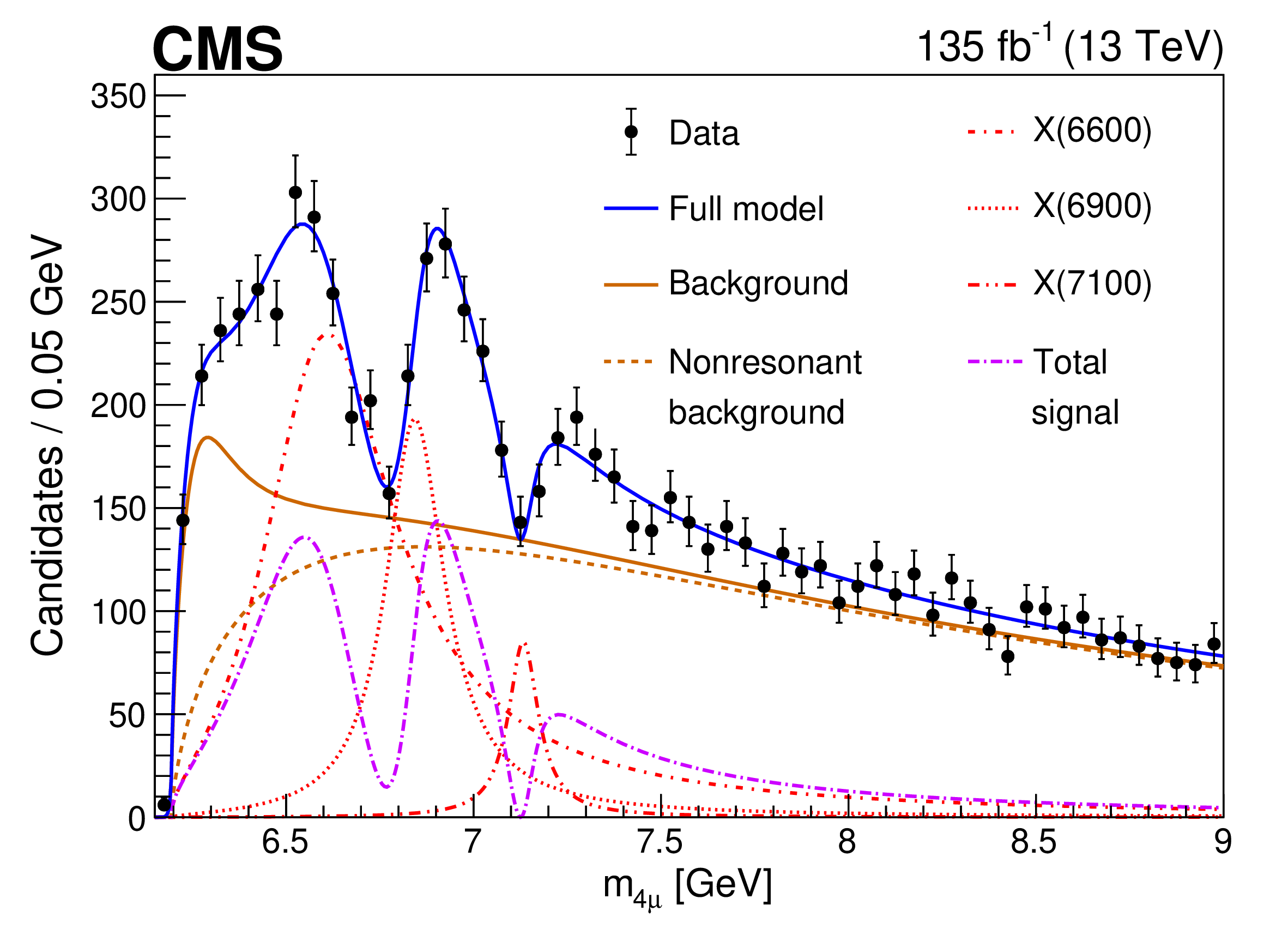
Upon close inspection, the tetraquark family members are consistent with tightly bound diquark pairs
The CMS Collaboration has identified three extremely rare same-flavor teraquark states and determined, based on their spin-parity configuration, that they are consistent with a diquark-antidiquark model.
In recent years, a long-standing orthodoxy that all strongly interacting particles (hadrons) are either pairs (mesons) or triplets (baryons) of quarks (q) has been fundamentally overturned. Rapid progress has been made in identifying a plethora of candidates for “exotic hadrons”, including tetraquarks (qq̅qq̅) and pentaquarks (qqqqq̅), now recognized within the scientific community.
A groundbreaking advance is the identification of a family of three candidates for all-charm tetraquarks, two of which have been reported by CMS for the first time. All were observed by the CMS Collaboration in the J/ψJ/ψ channel, where each J/ψ is reconstructed in the dimuon channel. The J/ψ meson is the best-known example of a charmonium state. Figure 1 illustrates CMS's published J/ψJ/ψ mass distribution corresponding to Run 2 data (collected from 2016 to 2018), where the three structures are clearly discernible. Unusual dips in the J/ψJ/ψ mass distribution around 6.7 and 7.1 GeV were better described by incorporating quantum mechanical interference, which implies that the three resonances share identical quantum numbers.

Figure 1: The CMS J/ψJ/ψ mass distributions showing data collected during Run 2 showing a triple-peaking structure.
The observation of an all-charm tetraquark candidate has sparked intense interest within the physics community. The measurement of their specific quantum numbers is crucial to further unravel the mystery surrounding these states, enabling physicists to differentiate between competing models and shed light on the fundamental nature of these resonances. In complex bound states like tetraquarks, several quantum numbers characterize the nature of the system: its total angular momentum (J) is determined by the combination of the spins (S) and orbital angular momenta (L) of the elementary constituent particles. In addition to having S = 1/2, quarks possess a property known as “color” rooted in quantum chromodynamics, which explains why quarks are never found in isolation; they are perpetually locked together in color-balanced groups. Finally, parity serves as a symmetry test often referred to as the “mirror rule”, which aids physicists in classifying particles and understanding the underlying forces at play. Back in the 1950s, scientists were astonished to discover that the weak nuclear force can completely violate this mirror rule. However, for strong-force bound states like tetraquarks, parity is conserved.

Figure 2: Diagram showing the internal structure models for the tetraquark (X) particle and its decay chain, with the top representing the “diquark-antidiquark” model and the bottom representing the “molecule” model.
Two widely used models, the diquark-antidiquark (Fig. 2, top) and the molecule (Fig. 2, bottom), have been proposed to explain the family of all-charm tetraquarks. Both models divide the four charm quarks (cc̅cc̅) into two subsystems. In the diquark-antidiquark model, each subsystem consists of two identical quarks (cc) or two identical antiquarks (c̅c̅), with the two subsystems bound together by the strong force. Since each subsystem comprises two identical particles, a spin of 1 for each is preferred due to the Pauli exclusion principle. Conversely, in the molecule model, where the tetraquark is a weakly bound meson-meson (qq̅-qq̅) system, the colorless mesons stick together from residual strong force attraction and their spin is unconstrained since each meson subsystem is distinct.
A sophisticated matrix-element likelihood approach was developed by CMS, which integrates all angular information into a single discriminator, thus enabling the identification of various spin-parity configurations without relying on multiple variables. CMS physicists apply this method to the triplet of tetraquarks to test hypotheses of spin 0, 1, or, 2, with both positive and negative parity. By assuming all three resonances share the same quantum numbers, the analysis rejects negative parity, while total angular momentum J = 0 or 1 are excluded, establishing J=2 with positive parity and charge conjugation as the favored configuration.
Furthermore, CMS extracts additional insights into the tetra-charm state’s possible orbital angular momentum. For a system composed of two constituents, an angular momentum L = 1 is ruled out due to the exclusion of negative parity, as positive parity necessitates even L values. Although L = 2 is feasible, it requires higher energy and is thus less favored, leaving L = 0 as the preferred choice.
Spin-2 states are rare among traditional hadrons and even rarer in exotic hadrons, which renders the newly identified triplet of all-charm tetraquarks particularly interesting. The diquark-antidiquark model requires both diquarks to have spin 1 in the ground state, naturally leading to a J = 2 configuration with L = 0. Thus, the spin-parity of the triplet measured by CMS strongly supports the diquark-antidiquark model.
Looking forward, CMS anticipates collecting nearly 10 times more J/ψJ/ψ events by combining data from 2022 through 2026, utilizing various decay channels and significantly improved triggers. With this substantially larger statistical sample, CMS aims to measure the spin-parity of each resonance individually, rather than assuming they share the same quantum numbers. These efforts promise to further illuminate the intricate landscape of exotic hadrons and enhance our understanding of the strong interaction.
Written by: Yi Kai, for the CMS Collaboration
Edited by: Andrés G. Delannoy
Read more about these results:
-
CMS Publication (BPH-24-002): "Determination of the spin and parity of all-charm tetraquarks"
-
Read about this result in Nature: "Determination of the spin and parity of all-charm tetraquarks"
-
@CMSExperiment on social media: Bluesky - Facebook - Twitter - Instagram - LinkedIn - TikTok - YouTube

